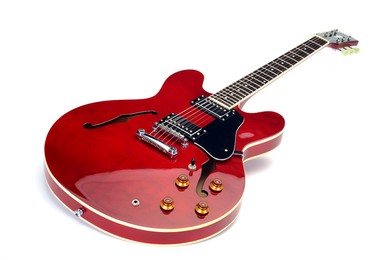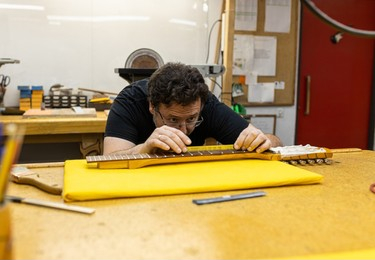Are you wondering how big a guitar neck is? The size of a guitar neck can greatly impact the playability and comfort of a guitar, making it an important factor to consider when choosing a guitar.
Most guitar necks range from about 1.5 inches to 2 inches in width. Neck thickness can vary anywhere from about 0.75 inches to 1 inch or more and scale lengths typically range from 24 inches to 25.5 inches, although some guitars have longer or shorter scales.
In this article, I will discuss the different types of guitar necks and their sizes to help you find the perfect guitar neck for your playing style.
How Big Is a Guitar Neck?
Now that we’ve covered the basic anatomy of a guitar neck, let’s explore some of the factors that determine its size and shape.
Neck Width
The width of a guitar neck is an important factor in determining how comfortable it is to play. Most guitar necks range from about 1.5 inches to 2 inches in width, although some are narrower or wider depending on the player’s preference.
Neck Thickness
The thickness of a guitar neck also affects how comfortable it is to play. Some players prefer thicker necks, while others prefer thinner ones. Neck thickness can vary anywhere from about 0.75 inches to 1 inch or more.
Scale Length
The scale length of a guitar neck is the distance between the nut and the bridge, and it affects the overall sound and feel of the instrument. Scale lengths typically range from 24 inches to 25.5 inches, although some guitars have longer or shorter scales.
Neck Profile
The neck profile refers to the shape of the back of the neck. There are several different profiles available, including “C,” “D,” and “V” shapes. The profile you choose can affect how comfortable the guitar is to play, as well as the sound it produces.
Neck Shape
The neck shape is another important factor in determining how comfortable a guitar is to play. Some necks have a flatter profile, while others are more rounded. The shape of the neck can also affect the sound of the guitar, as well as the player’s ability to reach certain frets.
Guitar Neck Sizes
Here are some common guitar neck sizes for different types of guitars:
Acoustic Guitar Neck Width

The width of an acoustic guitar neck can vary depending on the specific guitar model and brand. However, as a general rule, the width of the nut (the small, slotted piece at the top of the neck where the strings are inserted) can range from about 1.5 inches (38 mm) to 1.75 inches (44 mm).
Some guitars may have a narrower or wider neck to accommodate different playing styles or hand sizes. For example, guitars with narrow necks are often preferred by players with smaller hands, while wider necks can provide more space for fingerpicking and complex chord shapes.
Electric Guitar Neck Width

The width of the neck on an electric guitar can also vary depending on the specific model and brand.
However, as a general rule, the width of the nut on an electric guitar is typically between 1.625 inches (41.3 mm) and 1.75 inches (44.5 mm).
Classical Guitar Neck Width

Classical guitars typically have wider necks to accommodate the nylon strings and fingerstyle playing technique. The neck width of a classical guitar can range from 50mm to 54mm.
Bass Guitar Neck Width

Bass guitars usually have wider necks than electric guitars, with a neck width ranging from 42mm to 54mm allowing for more spacing between the strings, making it easier for the player to navigate the fretboard and play basslines.
How to Measure Guitar Neck Width?

Here’s a step-by-step guide to measuring guitar neck width:
Gather Your Tools
To measure the width of a guitar neck, you will need a ruler or tape measure, a straight edge or a carpenter’s square, and a piece of paper and pen to record your measurements.
Position Your Guitar
Place your guitar on a flat surface with the neck facing upwards. Make sure the guitar is stable and won’t move around during the measurement process.
Find the Nut
The nut is a small, white piece of material located at the top of the neck, just before the headstock. This is where the strings are held in place before they are stretched over the fretboard.
Measure the Width
Using your ruler or tape measure, measure the width of the neck at the nut. Place the straight edge or carpenter’s square perpendicular to the neck at the nut, and measure the distance between the two outermost strings. This will give you the width of the neck at the nut.
Record Your Measurements
Write down your measurement on a piece of paper, along with the make and model of your guitar. If you’re measuring multiple guitars, be sure to label each measurement with the corresponding guitar.
Types of Guitar Necks

There are several types of guitar necks, each with a different shape and feel. The most common types of guitar necks are C-shape, V-shape, U-shape, and thin, and fat necks.
C-Shape Neck
The C-shape neck is the most common type of guitar neck and is found on most Fender guitars. It has a comfortable, rounded shape that fits snugly in the player’s hand.
V-Shape Neck
The V-shape neck has a more angular shape than the C-shape neck and is commonly found on Gibson guitars. It provides a different feel and grip for players who prefer a more distinct shape.
U-Shape Neck
The U-shape neck is similar to the C-shape neck but has a more pronounced curve on the back of the neck. It provides a more comfortable grip for players with larger hands.
Thin Neck
The thin neck is a popular choice for players who want a fast-playing guitar. It has a slim profile and is often found on shred-style guitars.
Fat Neck
The fat neck is the opposite of the thin neck and is often preferred by players who want a more substantial grip on the neck. It provides a more traditional feel and is commonly found in vintage-style guitars.
How to Choose the Right Guitar Neck Size
Choosing the right guitar neck size is a matter of personal preference and playing style. It’s important to try out different types and sizes of guitar necks to find the one that feels comfortable and suits your playing needs. Here are some things to consider when choosing a guitar neck size:
- Hand size: Players with larger hands may prefer a wider neck, while players with smaller hands may prefer a narrower neck.
- Playing style: If you play a lot of chords and rhythm guitar, a narrower neck may be more comfortable. If you play lead guitar and need to navigate the fretboard quickly, a wider neck may be more suitable.
- Genre: Different genres of music may require different neck sizes. For example, jazz guitarists often prefer wider necks for their fingerstyle playing, while rock guitarists may prefer thinner necks for their fast soloing.
FAQs
What is the size of a guitar neck?
The size of a guitar neck can vary depending on the type of guitar. Classical guitars typically have wider necks to accommodate nylon strings and fingerstyle playing, while electric guitars can have thin or thick necks depending on the player’s preference.
How long is a guitar neck in CM?
The length of a guitar neck can vary, but a typical full-scale guitar neck is around 64-65cm in length.
How long is a full-size guitar neck?
A full-size guitar neck is usually around 25.5 inches or 64-65cm in length.
How thick is a guitar neck in MM?
The thickness of a guitar neck can vary depending on the player’s preference and the type of guitar. A typical electric guitar neck can be around 20-22mm thick at the first fret, while a classical guitar neck can be around 24-26mm thick.
What is the best guitar neck size?
The best guitar neck size is subjective and depends on the player’s hand size, playing style, and genre of music. It’s important to try out different neck sizes and types to find the one that feels comfortable and suits your playing needs.